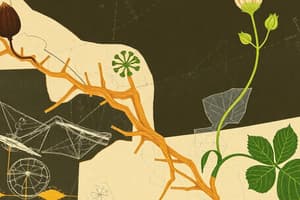Podcast
Questions and Answers
What is the primary function of sieve tubes in the phloem?
What is the primary function of sieve tubes in the phloem?
- Storage of excess water
- Transportation of food material (correct)
- Support and mechanical strength
- Absorption of minerals
Which of the following statements about companion cells is true?
Which of the following statements about companion cells is true?
- They are found only in the roots.
- They are responsible for storing food.
- They support the sieve tubes in food conduction. (correct)
- They are dead and provide mechanical strength.
How does the conduction of materials differ between xylem and phloem?
How does the conduction of materials differ between xylem and phloem?
- Xylem conducts food, while phloem conducts water.
- Both tissues conduct materials contributing to mechanical support.
- Both xylem and phloem only conduct minerals.
- Xylem conducts materials unidirectionally, while phloem conducts bidirectionally. (correct)
Which cell type in phloem is responsible for providing mechanical support?
Which cell type in phloem is responsible for providing mechanical support?
What denotes the uniqueness of sieve plates in phloem?
What denotes the uniqueness of sieve plates in phloem?
Which statement accurately describes phloem parenchyma?
Which statement accurately describes phloem parenchyma?
What type of cells makes up the majority of the xylem tissue?
What type of cells makes up the majority of the xylem tissue?
Which term best describes the energy requirement for phloem conduction?
Which term best describes the energy requirement for phloem conduction?
Flashcards are hidden until you start studying
Study Notes
Phloem Tissue
- Consists of four types of cells: sieve tubes, companion cells, phloem parenchyma, and phloem fibres.
- Sieve tubes:
- Cylindrical cells lacking a nucleus.
- Arranged in vertical rows, end to end.
- Perforated end walls called sieve plates allow food material to pass from cell to cell.
- Companion cells:
- Living, thin-walled, elongated cells attached to sieve tubes.
- Assist sieve tubes in food conduction.
- Phloem parenchyma:
- Thin-walled parenchymatous cells that store food.
- Phloem fibres:
- Dead sclerenchyma fibres formed of elongated cells.
- Provide mechanical strength and support to the plant.
Functions of Phloem
- Translocates food produced by leaves to all parts of the plant.
- Phloem parenchyma stores food.
- Phloem sclerenchyma (fibres) provides mechanical support.
Conducting Tissues in Plants
- Xylem Tissue:
- Tracheids
- Vessels
- Xylem parenchyma
- Xylem fibres
- Phloem Tissue:
- Sieve tubes
- Companion cells
- Phloem parenchyma
- Phloem fibres
Xylem vs. Phloem
- Xylem:
- Conducts water and mineral salts from roots to aerial parts of the plant.
- Composed of tracheids, vessels, xylem parenchyma, and xylem fibres.
- Conducting cells (vessels and tracheids) are dead.
- Unidirectional conduction.
- Does not require energy expenditure.
- Phloem:
- Translocates food from leaves to storage organs and growing parts of the plant.
- Composed of sieve tubes, companion cells, phloem parenchyma, and phloem fibres.
- Conducting cells (sieve tubes) are living.
- Bidirectional conduction.
- Requires energy expenditure.
Studying That Suits You
Use AI to generate personalized quizzes and flashcards to suit your learning preferences.




